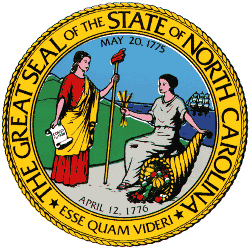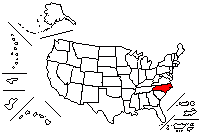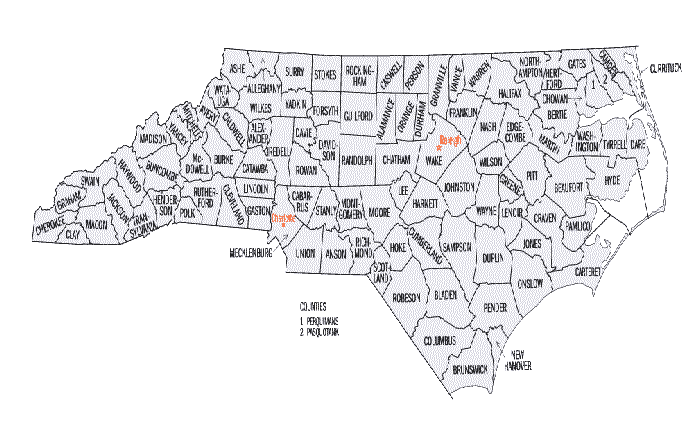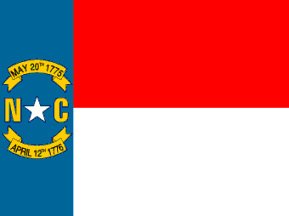
 |
|

















The Old North State
Written by William Gaston
Composed by Mrs. E. E. Randolph
Carolina! Carolina! Heaven's blessings attend her!
While we live we will cherish, protect and defend her;
Tho' the scorner may sneer at and witlings defame her,
Still our hearts swell with gladness whenever we name her.
Hurrah! Hurrah! The Old North State forever!
Hurrah! Hurrah! The good Old North State!
Tho' she envies not others, their merited glory,
Say whose name stands the foremost, in Liberty's story,
Tho' too true to herself e'er to crouch to oppression,
Who can yield to just rule a more loyal submission?
Hurrah! Hurrah! The Old North State forever!
Hurrah! Hurrah! The good Old North State!
Plain and artless her sons, but whose doors open faster
At the knock of a stranger, or the tale of disaster.
How like the rudeness of the dear native mountains,
With rich ore in their bosoms and life in their fountains.
Hurrah! Hurrah! The Old North State forever!
Hurrah! Hurrah! The good Old North State!
And her daughters, the Queen or the forest resembling
So graceful, so constant, yet the gentlest breath trembling.
And true lightwood at heart, let the match be applied them,
How they kindle and flame! Oh! none know but who've tried them.
Hurrah! Hurrah! The Old North State forever!
Hurrah! Hurrah! The good Old North State!
Then let all those who love us, love the land that we live in,
As happy a region as on this side of heaven,
Where plenty and peace, love and joy smile before us,
Raise aloud, raise together the heart thrilling chorus.
Hurrah! Hurrah! The Old North State forever!
Hurrah! Hurrah! The good Old North State!
The song known as "The Old North State" was adopted as the official
song of the State of North Carolina by the General Assembly of 1927.


Flag:
That the flag of North Carolina shall consist of a blue union, containing in the center thereof
a white star with the letter N in gilt on the left and the letter C in gilt on the right of said
star, the circle containing the same to be one-third the width of the union.
The fly of the flag shall consist of two equally proportioned bars; the upper bar to be red,
the lower bar to be white; that the length of the bars horizontally shall be equal to the
perpendicular length of the union, and the total length of the flag shall be one-third more
than its width. That above the star in the center of the union there shall be a gilt scroll
in semi-circular form, containing in black letters this inscription "May 20th, 1775,"
and that below the star there shall be a similar scroll containing in black letters the
inscription: "April 12th, 1776."
Bandera: La bandera de Carolina del Norte consistirá en una unión azul, conteniendo en el centro una estrella blanca con la letra N dorada la izquierda y la letra C dorada en la derecha de dicha estrella. La bandera consistirá en dos barras igualmente proporciónadas; la barra superior a ser roja, la barra más baja a ser blanca; y la longitud de las barras será horizontalmente igual a la longitud perpendicular de la unión, y a la longitud total de la bandera sea una mitad más que su anchura. Sobre la estrella en el centro de la unión habrá una cinta de dorada en forma semicircular, conteniendo en negro a esta inscripción "20 de mayo de 1775," y en la de debajo de la estrella habrá una cinta similar que contiene en negro la inscripción: " 12 de abril de 1776."

North Carolina
Nor-Carolina o Carolina del Norte
National: North Carolinians
Capital City: Raleigh
Admission to Statehood: November 21, 1789
Border States: Georgia / South Carolina / Tennessee / Virginia
Motto: Esse quam videri
To be, rather than to seem
This motto, adopted with the great seal in 1893, can be
found in Cicero. It is an expression of the character of the citizens of North Carolina.
Nickname: Old North State / Tar Heel State
Origin of state's name: Named by England. Taken from "Carolus,"
the Latin word for Charles and named after England's King Charles I.
Gentilicio: Nor-Carolinenses
Ciudad Capital: Raleigh
Admición como estado: 21 de noviembre de 1789
Estados limítrofes: Georgia / South Carolina / Tennessee / Virginia
Lema: Esse quam videri - Mejor ser que aparentar
Este lema, adoptado con el gran sello en 1893, se puede encontrar en
Cicerón. Es una expresión del carácter de los ciudadanos de Carolina del Norte.
Cognómento: El Viejo Estado del Norte / El estado de "Tar Heel"
Origen del Nombre: Dado por Inglaterra. Tomado de "Carolus", la palabra latina para
Carlos y nombrado en honor al rey de Inglaterra Carlos I.


The Seal:
"The Governor shall procure of the State a Seal, which shall be called the great seal of the
State of North Carolina, and shall be two and one-quarter inches in diameter, and its design
shall be a representation of the figures of Liberty and Plenty, looking toward each other,
but not more than half-fronting each other and other-wise disposed as follows: Liberty,
the first figure, standing, her pole with cap on it in her left hand and a scroll with the
word "Constitution" inscribed thereon in her right hand. Plenty, the second figure, sitting
down, her right arm half extended toward Liberty, three heads of grain in her right hand,
and in her left, the small end of her horn, the mouth of which is resting at her feet, and
the contents of the horn rolling out.
The background on the seal shall contain a depiction of mountains running from left to right
to the middle of the seal. A side view of a three-masted ship shall be located on the ocean
and to the right of Plenty. The date "May 20, 1775" shall appear within the seal and across
the top of the seal and the words "esse quam videri" shall appear at the bottom around the
perimeter. No other words, figures or other embellishments shall appear on the seal."
But even this standard was not the final word on the subject. In 1983, the state ratified
another change that had been proposed by former Senator Jullian R. Allsbrook. Since the state
flag carried the date of the adoption of the Halifax Resolves, Allsbrook felt that the State
Seal should do likewise to serve as a reminder of the state's commitment to liberty. Thus,
the Great Seal of the State of North Carolina was modified to show the date of the Resolves,
April 12, 1776.
" el gobernador procurará del estado un sello, que será llamado el
gran sello del estado de Carolina del Norte, y será dos y un cuarto
pulgada de diámetro, y su diseño será una representación de las
figuras de la libertad y de la abundancia, mirandose unos a otros y
dispuesto de la manera como sigue:
La libertad, la primera figura, de pies, su bastón con un birrete
en él en su mano izquierda y un pergamino con la palabra "
constitución " su mano derecha. La
abundancia, la segunda figura, sentada, su brazo derecho
extendió a medias hacia la libertad, tres cabezas de granos en su mano
derecha, y en su izquierda, el extremo pequeño del cuerno, cuya boca está
a sus pies, y el contenido del
del cuerno hacia fuera.
El fondo en el sello contendrá una pintura de las montañas que
van de izquierda a derecha al centro del sello. Una vista
lateral de una nave de tres mástiles será situada en el océano y a
la derecha de abundancia. La fecha " de mayo el 20 de 1775 "
aparecerá dentro del sello y en la parte superior del sello y las palabras
" videri del quam del esse " aparecerá en el fondo alrededor
del perímetro. Ningunas otras palabras, las figuras u otros adornos
aparecerán en el sello."
Pero incluso este estándar no era la palabra final en el tema. En
1983, el estado ratificó otro cambio que había sido propuesto por
senador anterior Jullian R. Allsbrook. Puesto que la bandera del
estado llevó la fecha de la adopción de las resoluciones de Halifax,
Allsbrook se sentía que el sello del estado debe hacer además para
servir como recordatorio de la comisión del estado a la libertad.
Así, el gran sello del estado de Carolina del norte fue modificado
para demostrar la fecha de las resoluciones, el 12 de abril de 1776.
In 1971, North Carolina's General Assembly resolved to standardize the design of the state's
seal. Prior to this resolution, the seal took on many different design variations.
The ship which appears i the background of the present seal, for example, had totally
disappeared from some previous seals. Mottos and dates came and went, and the images changed
with the artists and office holders. So, the General Assembly passed this resolution in 1971:
En 1971, la Asamblea General de Nor-Carolina o Carolina del Norte
resolvió
estandardizar el diseño del sello del estado. Antes de esta
resolución, el sello adquirió muchas diversas variaciones del
diseño. La nave que aparece en el fondo del actual sello, por
ejemplo, había desaparecido totalmente de algunos sellos anteriores.
Los lemas y las fechas vinieron y fueron, y las imágenes cambiaron
con los artistas. Así pues, la
Asamblea General pasó esta resolución en 1971:

History
North Carolina occupies a median location along the Atlantic
seaboard and is bounded on the south by South Carolina and
Georgia, on the west by Tennessee, on the north by Virginia,
and on the east by the Atlantic Ocean. In area the state ranks
29th, and in population it ranks 10th. Raleigh is the state
capital. North Carolinians are called Tar Heels, a nickname
the origin of which is still debated
The first Europeans to visit the North Carolina coast were
French explorers led by Giovanni da Verrazano in 1524.
In 1526 a group of Spanish sailors established a temporary
colony of more than 500 persons, probably at the mouth of
the Cape Fear River. A 1540 expedition by Hernando de Soto
crossed what is now western North Carolina before turning west
to discover the Mississippi River.
It was the English, however, who made the first permanent
European settlements in North Carolina, and the Roanoke
Island settlement (1585-86) of Sir Walter Raleigh was the
first English colony in the New World. A second group set
sail from England in 1587 but had vanished by 1590 when a
supply ship arrived. The mystery of the colony's disappearance
has never been solved. Among the settlers was the first child
born of English parents in America, Virginia Dare.
In 1729, North Carolina became a crown colony when George II
purchased the shares of Carolina from all the lords proprietors
except Lord Granville. Until the outbreak of the Revolution in 1775,
a more efficient government brought about increased settlement
and greater prosperity. The population increased from about
30,000 in 1729 to 265,000 in 1775, and settlement extended to
the Blue Ridge Mountains and beyond. With this transmontane
movement came the deep-seated differences between east and
west that have continued to the present day. The colonial
government was dominated by the eastern planters, and the
more egalitarian and poorer west suffered from corrupt
government and excessive taxes. The conflict resulted in
the War of Regulation* in which the western
insurgents were crushed by Gov. William Tryon (1729-88) at
the Battle of Alamance Creek on May 16, 1771.
In 1747-48 the Spanish attacked the North Carolina coast.
Troops from North Carolina assisted British troops
in the capture of Fort Duquesne during the French and
Indian War** (1754-63) and fought the Cherokee on the western
frontier in 1760. Yet, North Carolina was among the leaders
in resistance to British rule in the 1760s, and in 1765-66 its
armed citizens prevented enforcement of the Stamp Act*** in the
colony.
British rule came to an end in North Carolina when Gov.
Josiah Martin fled New Bern in May 1775. The Second Provincial
Congress in 1775 established two regiments and a state government.
The first battle of the Revolution in North Carolina was fought
against Scottish Loyalists at Moore's Creek Bridge on
Feb. 27, 1776. Later that year the Fifth Provincial Congress
adopted a state constitution and elected Richard Caswell
the first governor. North Carolina was the first colony to
declare officially its readiness for independence and in
April 1776 furnished ten regiments to the Continental army,
as well as thousands of militiamen. At the same time, it helped
defeat the Cherokee and suppressed the Tory residents who made
the revolution virtually a civil war in North Carolina. Despite
its leadership in the Revolution, North Carolina was the next to
last of the 13 original states to ratify the federal Constitution
(November 1789). In 1789, North Carolina ceded its western territory,
present-day Tennessee, to the federal government.
The U.S. Civil War brought this improving trend to an end.
North Carolina, though sympathetic to the South, was the
next to last state to secede, on May 20, 1861.
The battles of Fort Hatteras, Plymouth, Fort Fisher,
and Bentonville, as well as Sherman's 1865 invasion and
Johnston's surrender to Sherman near Durham on Apr. 26,
1865, were the most notable Civil War events in the state.
Wartime political and social disruptions were exacerbated
during Reconstruction. The Democratic party regained
legislative control in 1870 and removed from office
Gov. W. W. Holden, reelecting wartime governor Z. B.
Vance in 1876 to end the Reconstruction period in the state.
In 1880 the state began to industrialize and to urbanize
for the first time. The new industrialization
(called the First Cotton Mill Campaign) brought
additional jobs to the Piedmont but only modest
prosperity because of low wages. Agricultural
production increased, but farmers were burdened by
low prices, heavy debt, and widespread farm tenancy.
By the turn of the century, major advances were made
in the educational system, which had virtually collapsed
during Reconstruction. World War I boosted the economy and
led to the establishment of important military bases,
including Fort Bragg.
*The Regulator movements in North Carolina and South Carolina were
the products of sectional and economic conflict on the eve of the
American Revolution. Both movements were tied more closely
to local discontent than they were to any widespread dissatisfaction
with British rule. In fact, many of the Regulators later sided with
the crown against the colonial ruling class that led the independence
movement.
**The French and Indian Wars were a series of armed
conflicts between England's colonies in North America
on the one side and rival European colonies on the other
during the period 1689-1763. Each conflict was part of a
larger war in Europe and on the high seas.
***The Stamp Act (Mar. 22, 1765), sponsored by George Grenville,
was the first direct tax imposed by Britain on its American
colonies. To help cover the cost of maintaining troops in the
colonies.
Los primeros europeos para llegar a la costa de Carolina del norte fueron
exploradores franceses conducidos por Giovanni da Verrazano in 1524.
En 1526 al grupo de marineros españoles estableció a una
colonia temporal de más de 500 personas, probablemente en la boca del
Cape Fear River. Una expedición 1540 de Hernando de Soto
cruzó cuál ahora es Carolina del norte occidental antes de dar
vuelta al oeste para descubrir el río de Mississippi.
Fueron los Ingleses, sin embargo, que hicieron los primeros establecimientos
europeos permanentes en Carolina del norte, y el establecimiento de la
isla de Roanoke (1585-86) de sir Walter Raleigh fué la primera colonia
inglesa en el mundo nuevo. Un segundo grupo salió de
Inglaterra en 1587 pero la colonia había desaparecido por 1590 cuando llegó una
nave de proviciones. El misterio de la desaparición de la colonia
nunca no se ha solucionado. Entre los colonos estaba el primer niño
nacido de padres ingleses en de América, Virginia Dare.
En 1729, Carolina del norte se convirtió en una colonia de la corona
cuando George II compró las partes de Carolina de todos los
propietarios de los señores excepto señor Granville. Hasta el brote
de la revolución en 1775, un gobierno más eficiente trajo el
establecimiento alrededor creciente y la mayor prosperidad. La
población creciente de cerca de 30.000 en 1729 a 265.000 de 1775, y
el establecimiento extendieron a las Blue Ridge Mountains y más
allá. Con este movimiento vineron las diferencias
profundamente arraigadas entre el este y
del oeste que ha continuado a hoy. El gobierno colonial fue dominado
por los plantadores del este, y el oeste más igualitario y más pobre
sufrió del gobierno corrupto y de impuestos excesivos. El conflicto
dio lugar a la guerra de la regulación* en cuál Gov. William
Tryon (1729-88) aplastaron a los insurrectos occidentales en la batalla
del Alamance Creek el 16 de mayo de 1771.
En 1747-48 los españoles atacaron la costa de Carolina del norte.
Las tropas de Carolina del norte asistieron a tropas británicas en la
captura de la Fort Duquesne durante la guerra indio-francesa**(1754-63)
y lucharon contra los cherokee en la frontera occidental en
1760. Todavía, Carolina del norte estaba entre los líderes en
resistencia al régimen británico en el 1760s, y en 1765-66 sus
ciudadanos armados previnieron la aplicación del Stamp Act*** (acta de
la estampilla) en la colonia.
El régimen británico terminó en Carolina del norte cuando el gobernador
Josiah Martin huyó a New Bern en mayo de 1775. El segundo congreso
provincial en 1775 estableció dos regimientos y un gobierno del
estado. La primera batalla de la revolución en Carolina del norte
fue luchada contra leales escoceses en el Moore's Creek Bridge
el 27 de febrero de 1776. Más adelante el quinto
congreso provincial adoptó una constitución del estado y eligió a
Richard Caswell el primer gobernador. Carolina del norte era la
primera colonia para declarar oficialmente su preparación para la
independencia y en abril 1776 equipó diez regimientos al ejército
continental, así como millares de militares. En el mismo tiempo,
ayudó a derrota a los cherokee y suprimido los residentes de Tory que
hicieron la revolución virtualmente una guerra civil en Carolina del
norte. A pesar de su liderato en la revolución, Carolina del norte
fué último de los 13 estados originales en ratificar la
constitución federal (noviembre de 1789). En 1789, Carolina del
norte cedió su territorio occidental, Tennessee actual, al gobierno
federal.
La guerra civil de ESTADOS UNIDOS, Carolina del norte, aunque comprensiva al sur, fué el último
estado en separarse, el 20 de mayo de 1861. Las batallas
de Fort Hatteras, Plymouth, Fort Fisher,
y Bentonville, así como la invasión 1865 de Sherman y la entrega de
Johnston a Sherman cerca de Durham el 26 de abril de 1865, fueron los
acontecimientos más notables de la guerra civil del estado. Las
interrupciones políticas y sociales del tiempo de guerra fueron
exacerbadas durante la reconstrucción. El partido democrata
recuperó el control legislativo en 1870 y removieron del gobierno a W. W.
Holden, reeligiendo a gobernador Z. B. Vance del tiempo de
guerra en el 1876 al finalizar el período de la reconstrucción en
el estado.
En 1880 el estado comenzó a industrializar y a urbanizar par la
primera vez. La nueva industrialización (llamada la primera campaña
de la fábrica de algodón) trajo trabajos adicionales al Piedmont
pero solamente prosperidad modesta debido a salarios bajos. La
producción agrícola aumentaron, pero a los granjeros fueron cargados
por precios
bajos, deuda altas, y arrendamiento extenso de la granja. A finales
del siglo, los avances importantes fueron hechos en el sistema
educativo, que se había derrumbado virtualmente durante la
reconstrucción. La primera guerra mundial condujo a la economía en el
establecimiento de bases militares importantes, incluyendo la
Fort Bragg.
* Los movimientos reguladores en Carolina del norte y Carolina del
sur eran los productos del conflicto seccional y económico en la
víspera de la revolución americana. Ambos movimientos se unieron
más de cerca al descontento local del régimen Británico. De hecho, muchos de los reguladores
se fueron al lado, más adelante, con la corona contra la clase colonial
que lidereaba el movimineto de la independencia.
** Las guerras francesas e indias fueron una series de conflictos
armados entre las colonias de Inglaterra en Norteamérica en el un
lado y las colonias europeas rivales en el otro durante el período
1689-1763. Cada conflicto era parte de una guerra más grande en
Europa y en los mares altos.
*** El acta de la estampilla (de Mrz. el 22 de 1765), patrocinado
por George Grenville, fué el primer impuesto directo impuesto por Gran
Bretaña ante sus colonias americanas para ayudar a cubrir el costo de
mantener un ejercito en las colonias.
The conflict in North Carolina came to a head around 1768 when
small farmers in the backcountry protested against the inequitable
and inefficient system of local government prevailing in their area.
Conflict between the Regulators and Governor William Tryon continued
for several years, culminating in the defeat of the farmers at the
Battle of Alamance on May 16, 1771. One of their leaders was executed
on the battlefield, and six Regulators were hanged for treason
following a court-martial.
The Regulators in South Carolina were also backcountry farmers.
Upset by banditry and Indian attacks about which their local
government did little, they formed associations in 1767; they
refused to pay taxes and took vigilante action to impose their
own form of law and order. In 1769, South Carolina set up a
court system for the backcountry and conditions stabilized there.
Carolina del norte ocupa una localización mediana a lo largo del
litoral atlántico y es limitada en el sur por Carolina del sur y
Georgia, en el oeste por Tennessee, en el norte por Virginia, y en el
este por el Océano Atlántico. En área el número 29 en tamaño, y en
la población es el número 10. Raleigh es la Capital del Estado. A los
Nor-Carolinenses se les conoce como "Tar Heels", un
apodo cuyo origuen todavía se discute.
El conflicto en Carolina del norte comenzó alrededor de 1768
en que los granjeros pequeños en el backcountry protestaron contra el
sistema no equitativo e ineficaz del gobierno local que prevalecía en
su área. El conflicto entre los reguladores y el gobernador
William Tryon continuaron por varios años, culminando en la derrota
de los granjeros en la batalla de Alamance el 16 de mayo de 1771.
Ejecutaron uno de sus líderes en el campo de batalla, y seis
reguladores fueron colgados por traisión después de una corte marcial.
Los reguladores en Carolina del sur eran también granjeros
enojados por los ataques bandidos y de los indios sobre los
cuales su gobierno local hizo poco, formaron asociaciones en 1767;
rechazaron pagar impuestos y tomaron la acción de vigilante para
imponer su propia forma de ley y de orden. En 1769, Carolina del sur
instaló un sistema judicial para el granjero y las condiciones se
estabilizaron allí.
